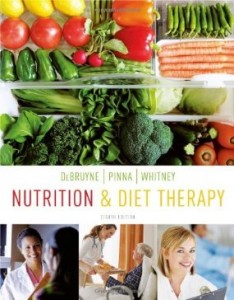This is completed downloadable of Test Bank for Nutrition and Diet Therapy, 8th Edition : DeBruyne

Product Details:
- ISBN-10 : 0840049447
- ISBN-13 : 978-0840049445
- Author:
NUTRITION AND DIET THERAPY, 8th Edition, is unique in its organization by diets rather than by organ systems or disease states and distinguishes itself through rich pedagogical features that require students to apply their knowledge as they learn it. This text provides core nutrition concepts and up-to-date clinical content at a level that is accessible to the range of health care team members who are responsible for a client’s nutrition needs. NUTRITION AND DIET THERAPY provides the basic facts and a wealth of practical information readers need to assume their responsibility for nutrition care.
Table of Content:
- 1 Overview of Nutrition and Health
- Food Choices
- The Nutrients
- Six Classes of Nutrients
- kCalories: A Measure of Energy
- Nutrient Recommendations
- Dietary Reference Intakes
- Acceptable Macronutrient Distribution Ranges (AMDR)
- National Nutrition Surveys
- Coordinating Nutrition Survey Data
- National Health Goals
- Dietary Guidelines and Food Guides
- Dietary Ideals
- Dietary Guidelines for Americans
- The USDA Food Guide
- MyPyramid
- Food Labels
- The Ingredient List
- Nutrition Facts Panel
- Claims on Labels
- NUTRITION IN PRACTICE: FINDING THE TRUTH ABOUT NUTRITION
- 2 Carbohydrates
- The Chemist’s View of Carbohydrates
- Monosaccharides
- Disaccharides
- Polysaccharides
- Health Effects of Sugars and Alternative Sweeteners
- Sugars
- Alternative Sweeteners
- Artificial Sweeteners and Weight Control
- Health Effects of Starch and Dietary Fibers
- Carbohydrates: Disease Prevention and Recommendations
- Carbohydrates: Food Sources
- Carbohydrates: Food Labels and Health Claims
- NUTRITION IN PRACTICE: THE GLYCEMIC INDEX IN NUTRITION PRACTICE
- 3 Lipids
- Roles of Body Fat
- The Chemist’s View of Lipids
- Triglycerides
- Fatty Acids
- Phospholipids
- Sterols
- Health Effects and Recommended Intakes of Fats
- Fats and Heart Health
- Recommendations
- Fats in Foods
- Finding the Fats in Foods
- Cutting Fat Intake and Choosing Unsaturated Fats
- NUTRITION IN PRACTICE: FIGURING OUT FATS
- 4 Protein
- The Chemist’s View of Proteins
- The Structure of Proteins
- Essential Amino Acids
- Protein Turnover and Nitrogen Balance
- Protein Turnover
- Nitrogen Balance
- Roles of Body Proteins
- Protein and Health
- Protein-Energy Malnutrition
- Protein Excess
- Protein and Amino Acid Supplements
- Protein Recommendations and Intakes
- Protein in Foods
- Protein Quality
- Protein Sparing
- NUTRITION IN PRACTICE: VEGETARIAN DIETS
- 5 Digestion and Absorption
- Anatomy of the Digestive Tract
- The Digestive Organs
- The Involuntary Muscles and the Glands
- The Process of Digestion
- Digestion in the Mouth
- Digestion in the Stomach
- Digestion in the Small and Large Intestines
- The Absorptive System
- The Small Intestine
- Absorption of Nutrients
- Transport of Nutrients
- The Vascular System
- The Lymphatic System
- Transport of Lipids: Lipoproteins
- The System at Its Best
- NUTRITION IN PRACTICE: FOOD SAFETY
- 6 Metabolism, Energy Balance, and Body Composition
- The Organs and Their Metabolic Roles
- The Principal Organs
- The Body’s Metabolic Work
- The Body’s Use of Fuels
- Energy Metabolism
- Glucose Production
- Energy Imbalance
- Feasting
- Fasting
- Energy Balance
- Energy In
- Energy Out
- Estimating Energy Requirements
- Body Weight, Body Composition, and Health
- Defining Healthy Body Weight
- Body Composition
- Health Risks Associated with Body Weight and Body Fat
- NUTRITION IN PRACTICE: EATING DISORDERS
- 7 Weight Management: Overweight and Underweight
- Causes of Obesity
- Genetics and Weight
- Environmental Stimuli
- Obesity Treatment: Who Should Lose?
- Inappropriate Obesity Treatments
- Over-the-Counter Weight-Loss Supplements
- Other Gimmicks
- Aggressive Treatments of Obesity
- Obesity Drugs
- Surgery
- Reasonable Strategies for Weight Loss
- A Healthful Eating Plan
- Physical Activity
- Behavior and Attitude
- Strategies for Weight Gain
- NUTRITION IN PRACTICE: FAD DIETS
- 8 The Vitamins
- Vitamins—An Overview
- The Fat-Soluble Vitamins
- Vitamin A and Beta-Carotene
- Vitamin D
- Vitamin E
- Vitamin K
- The Water-Soluble Vitamins
- The B Vitamins
- Thiamin
- Riboflavin
- Niacin
- Pantothenic Acid and Biotin
- Vitamin B6
- Folate
- Vitamin B12
- Non–B Vitamins
- Vitamin C
- NUTRITION IN PRACTICE: PHYTOCHEMICALS AND FUNCTIONAL FOODS
- 9 Water and the Minerals
- Water and Body Fluids
- Water Balance
- Fluid and Electrolyte Balance
- Acid–Base Balance
- The Major Minerals
- Sodium
- Chloride
- Potassium
- Calcium
- Phosphorus
- Magnesium
- Sulfate
- The Trace Minerals
- Iron
- Zinc
- Selenium
- Iodine
- Copper
- Manganese
- Fluoride
- Chromium
- Other Trace Minerals
- NUTRITION IN PRACTICE: VITAMIN AND MINERAL SUPPLEMENTS
- 10 Fitness and Nutrition
- Fitness
- Benefits of Fitness
- The Essentials of Fitness
- The Active Body’s Use of Fuels
- Glucose Use during Physical Activity
- Fat Use during Activity
- Protein Use during Activity
- Vitamins and Minerals to Support Activity
- Supplements
- Nutrients of Special Concern
- Fluids and Electrolytes in Physical Activity
- Temperature Regulation
- Fluid Needs during Physical Activity
- Sports Drinks
- Enhanced Water
- Other Beverages
- Diets for Physically Active People
- NUTRITION IN PRACTICE: SUPPLEMENTS AND ERGOGENIC AIDS ATHLETES USE
- 11 Nutrition through the Life Span: Pregnancy and Lactation
- Pregnancy: The Impact of Nutrition on the Future
- Nutrition Prior to Pregnancy
- Prepregnancy Weight
- Healthy Support Tissues
- The Events of Pregnancy
- Nutrient Needs during Pregnancy
- Food Assistance Programs
- Weight Gain
- Weight Loss after Pregnancy
- Physical Activity
- Common Nutrition-Related Concerns of Pregnancy
- Problems in Pregnancy
- Practices to Avoid
- Adolescent Pregnancy
- Breastfeeding
- Nutrition during Lactation
- Contraindications to Breastfeeding
- NUTRITION IN PRACTICE: ENCOURAGING SUCCESSFUL BREASTFEEDING
- 12 Nutrition through the Life Span: Infancy, Childhood, and Adolescence
- Nutrition of the Infant
- Nutrient Needs during Infancy
- Breast Milk
- Infant Formula
- The Transition to Cow’s Milk
- Introducing First Foods
- Looking Ahead
- Mealtimes
- Nutrition during Childhood
- Energy and Nutrient Needs
- Hunger and Malnutrition in Children
- Lead Poisoning in Children
- Food Allergy
- Hyperactivity
- Childhood Obesity
- Mealtimes at Home
- Nutrition at School
- Nutrition during Adolescence
- Growth and Development during Adolescence
- Energy and Nutrient Needs
- Food Choices and Health Habits
- NUTRITION IN PRACTICE: CHILDHOOD OBESITY AND THE EARLY DEVELOPMENT OF CHRONIC DISEASES
- 13 Nutrition through the Life Span: Later Adulthood
- Nutrition and Longevity
- Slowing the Aging Process
- Nutrition and Disease Prevention
- Nutrition-Related Concerns during Late Adulthood
- Cataracts and Macular Degeneration
- Arthritis
- The Aging Brain
- Energy and Nutrient Needs during Late Adulthood
- Energy and Energy Nutrients
- Water
- Vitamins and Minerals
- Nutrient Supplements for Older Adults
- The Effects of Drugs on Nutrients
- Food Choices and Eating Habits of Older Adults
- Individual Preferences
- Meal Setting
- Depression
- Food Assistance Programs
- Meals for Singles
- NUTRITION IN PRACTICE: HUNGER AND COMMUNITY NUTRITION
- 14 Illness and Nutrition Care
- Nutrition in Health Care
- Effects of Illness on Nutrition Status
- Responsibility for Nutrition Care
- Nutrition Screening
- The Nutrition Care Process
- Nutrition Assessment
- Historical Information
- Food Intake Data
- Anthropometric Data
- Biochemical Analyses
- Physical Examinations
- Determining Energy Requirements
- Implementing Nutrition Care
- Dietary Modifications
- Approaches to Nutrition Care
- Documenting Nutrition Care
- Improving Food Intake
- NUTRITION IN PRACTICE: NUTRITIONAL GENOMICS
- 15 Medications, Diet-Drug Interactions, and Herbal Supplements
- Medications in Disease Treatment
- Risks from Medications
- Patients at High Risk of Adverse Effects
- Diet-Drug Interactions
- Drug Effects on Food Intake
- Drug Effects on Nutrient Absorption
- Dietary Effects on Drug Absorption
- Drug Effects on Nutrient Metabolism
- Dietary Effects on Drug Metabolism
- Drug Effects on Nutrient Excretion
- Dietary Effects on Drug Excretion
- Diet-Drug Interactions and Toxicity
- Herbal Supplements
- Effectiveness and Safety of Herbal Products
- Use of Herbal Products in Illness
- NUTRITION IN PRACTICE: COMPLEMENTARY AND ALTERNATIVE THERAPIES
- 16 Specialized Nutrition Support: Enteral and Parenteral Nutrition
- Enteral Nutrition Support
- Enteral Formulas
- Enteral Nutrition in Clinical Care
- Administration of Tube Feedings
- Medication Delivery through Feeding Tubes
- Tube Feeding Complications
- Transition to Table Foods
- Parenteral Nutrition Support
- Candidates for Parenteral Nutrition
- Venous Access
- Parenteral Solutions
- Administering Parenteral Nutrition
- Managing Metabolic Complications
- Nutrition Support at Home
- Candidates for Home Nutrition Support
- Planning Home Nutrition Care
- Quality-of-Life Issues
- NUTRITION IN PRACTICE: INBORN ERRORS OF METABOLISM
- 17 Foods and Food Consistency for Upper GI Disorders
- Modifications in Food Texture and Consistency
- Mechanically Altered Diets
- Clear Liquid Diet
- Conditions Affecting the Mouth and Esophagus
- Dry Mouth
- Dysphagia
- Gastroesophageal Reflux Disease
- Conditions Affecting the Stomach
- Dyspepsia
- Nausea and Vomiting
- Gastritis
- Peptic Ulcer Disease
- Gastric Surgery
- Gastrectomy
- Bariatric Surgery
- NUTRITION IN PRACTICE: NUTRITION AND ORAL HEALTH
- 18 Fiber-Modified Diets for Lower Gastrointestinal Tract Disorders
- Modifying Fiber Intake
- Disorders of Bowel Function
- Constipation
- Diarrhea
- Irritable Bowel Syndrome
- Inflammatory Bowel Diseases
- Diverticular Disease of the Colon
- Colostomies and Ileostomies
- NUTRITION IN PRACTICE: PROBIOTICS AND INTESTINAL HEALTH
- 19 Carbohydrate- and Fat-Modified Diets for Malabsorption Disorders
- Malabsorption Syndromes
- Evaluating Malabsorption
- Fat Malabsorption
- Bacterial Overgrowth
- Lactose Intolerance
- Disorders of the Pancreas
- Pancreatitis
- Cystic Fibrosis
- Disorders of the Small Intestine
- Celiac Disease
- Short Bowel Syndrome
- NUTRITION IN PRACTICE: ANEMIA IN ILLNESS
- 20 Nutrition Therapy for Liver and Gallbladder Diseases
- Fatty Liver and Hepatitis
- Fatty Liver
- Hepatitis
- Cirrhosis
- Consequences of Cirrhosis
- Treatment of Cirrhosis
- Nutrition Therapy for Cirrhosis
- Liver Transplantation
- Gallbladder Disease
- Types of Gallstones
- Consequences of Gallstones
- Risk Factors for Cholesterol Gallstones
- Treatment of Gallstones
- NUTRITION IN PRACTICE: ALCOHOL IN HEALTH AND DISEASE
- 21 Carbohydrate-Controlled Diets for Diabetes Mellitus
- Overview of Diabetes Mellitus
- Symptoms of Diabetes
- Diagnosis of Diabetes
- Types of Diabetes
- Acute Complications of Diabetes
- Chronic Complications of Diabetes
- Treatment of Diabetes Mellitus
- Treatment Goals
- Evaluating Diabetes Treatment
- Body Weight Concerns
- Nutrition Therapy: Nutrient Recommendations
- Nutrition Therapy: Meal-Planning Strategies
- Insulin Therapy
- Antidiabetic Drugs
- Physical Activity and Diabetes Management
- Sick-Day Management
- Diabetes Management in Pregnancy
- Pregnancy in Type 1 or Type 2 Diabetes
- Gestational Diabetes
- NUTRITION IN PRACTICE: THE METABOLIC SYNDROME
- 22 Fat-Controlled, Mineral-Modified Diets for Cardiovascular Diseases
- Atherosclerosis
- Consequences of Atherosclerosis
- Causes of Atherosclerosis
- Coronary Heart Disease (CHD)
- Evaluating Risk for Coronary Heart Disease
- Therapeutic Lifestyle Changes for Lowering CHD Risk
- Lifestyle Changes for Hypertriglyceridemia
- Vitamin Supplementation and CHD Risk
- Drug Therapies for CHD Prevention
- Treatment for Heart Attack
- Stroke
- Stroke Prevention
- Stroke Management
- Hypertension
- Factors That Influence Blood Pressure
- Factors That Contribute to Hypertension
- Treatment of Hypertension
- Heart Failure
- Consequences of Heart Failure
- Medical Management of Heart Failure
- NUTRITION IN PRACTICE: HELPING PEOPLE WITH FEEDING DISABILITIES
- 23 Protein-, Mineral-, and Fluid-Modified Diets for Kidney Diseases
- Nephrotic Syndrome
- Consequences of the Nephrotic Syndrome
- Treatment of the Nephrotic Syndrome
- Acute Kidney Injury
- Causes of Acute Kidney Injury
- Consequences of Acute Kidney Injury
- Treatment of Acute Kidney Injury
- Chronic Kidney Disease
- Consequences of Chronic Kidney Disease
- Treatment of Chronic Kidney Disease
- Kidney Transplants
- Kidney Stones
- Formation of Kidney Stones
- Consequences of Kidney Stones
- Prevention and Treatment of Kidney Stones
- NUTRITION IN PRACTICE: DIALYSIS
- 24 Energy- and Protein-Modified Diets for Metabolic and Respiratory Stress
- The Body’s Responses to Stress and Injury
- Hormonal Responses to Stress
- The Inflammatory Response
- Nutrition Treatment of Acute Stress
- Determining Nutritional Requirements
- Approaches to Nutrition Care in Acute Stress
- Nutrition and Respiratory Stress
- Chronic Obstructive Pulmonary Disease
- Respiratory Failure
- NUTRITION IN PRACTICE: MULTIPLE ORGAN DYSFUNCTION SYNDROME
- 25 Energy- and Protein-Modified Diets for Cancer and HIV Infection
- Cancer
- How Cancer Develops
- Nutrition and Cancer Risk
- Consequences of Cancer
- Treatments for Cancer
- Nutrition Therapy for Cancer
- HIV Infection
- Consequences of HIV Infection
- Treatments for HIV Infection
- Nutrition Therapy for HIV Infection
- NUTRITION IN PRACTICE: ETHICAL ISSUES IN NUTRITION CARE
- APPENDICES
- A Table of Food Composition
- B WHO: Nutrition Recommendations Canada: Guidelines and Meal Planning
- C Exchange Lists for Diabetes
- D Physical Activity and Energy Requirements
- E Nutrition Assessment: Supplemental Information
- F Aids to Calculations
- G Enteral Formulas
- H Answers to Self-Check Questions
- Glossary
- Index





